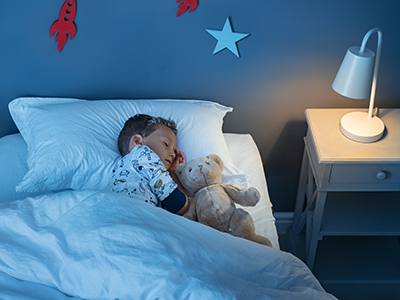As we mentioned in Toddler Sleep Tips Part 1 The Basics the optimal bedtime for toddlers is between 7- 8:30 pm. Let’s take a deeper look at ways to ease the bedtime process and cope with more verbal and active toddlers. Our sleep medicine expert, Daniel Lewin, PhD, helps answer some common concerns.
Bedtime routines
Many children are good at delaying bedtime by asking for another book, telling parents they need a drink of water, or continuously calling for a parent. Dr. Lewin says children are often looking for what they need, such as comfort. He recommends parents treat it as playful engagement and set limits. Read two books and respond to one call. But don’t make a habit of returning, which can often reinforce the behavior parents are trying to eliminate.
Coping with parents’ emotions
Dr. Lewin acknowledges that bedtime can be challenging for working parents, who often feel they don’t have enough time with their children, something he can relate to. Recognizing these feeling is important.
“If you’re feeling frustrated, guilty, or tested, acknowledging those feelings is important because you don’t want to translate this negative ambivalence to your child,” explains Dr. Lewin. “Don’t try to suppress these feelings. Acknowledge them, as what you’re feeling is often a good indication of what your child is feeling.”
Paying attention to how you’re feeling and acting during a non-stressful time, such as on a weekend or during vacation, can be a good way to model your bedtime rituals and behavior for more stressful weekdays when time together is more limited.
Waking up in the middle of the night
First, parents need to know that it’s completely normal for children to wake up between 5 to 10 times each night. That’s a lot! But it underscores why it’s so important to establish good sleep habits early on.
“The way a child learns to fall asleep at the beginning of the night and the cues that help make that transition to sleep are exactly what they’ll need in the middle of the night,” says Dr. Lewin. Often, that means the child wants a parent, so it’s important for children to learn to fall asleep on their own. Ideally, this begins between 3 to 6 months of age, says Dr. Lewin.
Recognizing signs of sleep problems
Dr. Lewin says parents should differentiate between full and partial awakening at night, which can be determined by how the child responds to the parent. If child becomes fussy and is difficult to calm, likely that child is having a mild parasomnia. The National Sleep Foundation defines a parasomnia as anything that disrupts sleep (other than sleep apnea), including night terrors and sleep walking.
Dr. Lewin says it can be disturbing for parents, as they can be pretty dramatic, but it’s important to recognize it. He says a pattern of sleep disruptions is a sign that the child’s sleep/wake cycle has been disrupted and the child likely needs more sleep.
Keeping a sleep log can be a good way to track sleep patterns and look for signs of trouble.
Parents, what challenges have you had with getting your toddler to sleep? What strategies have worked for your family?
 https://riseandshine.childrensnational.org/wp-content/uploads/2023/03/teen-sleeping-with-computer-feature.png
300
400
Rise and Shine
https://riseandshine.childrensnational.org/wp-content/uploads/2017/11/childrens_riseandshine_logo.jpg
Rise and Shine2023-03-09 15:18:342023-03-09 15:25:03Help! My teen’s sleep schedule is off
https://riseandshine.childrensnational.org/wp-content/uploads/2023/03/teen-sleeping-with-computer-feature.png
300
400
Rise and Shine
https://riseandshine.childrensnational.org/wp-content/uploads/2017/11/childrens_riseandshine_logo.jpg
Rise and Shine2023-03-09 15:18:342023-03-09 15:25:03Help! My teen’s sleep schedule is off


 Daniel S. Lewin, PhD, DABSM is a pediatric psychologist, sleep specialist and licensed clinical psychologist. He is Board Certified in Sleep Medicine and Behavioral Sleep Medicine.
Daniel S. Lewin, PhD, DABSM is a pediatric psychologist, sleep specialist and licensed clinical psychologist. He is Board Certified in Sleep Medicine and Behavioral Sleep Medicine.


















Leave a Comment
Want to join the discussion?Feel free to contribute!